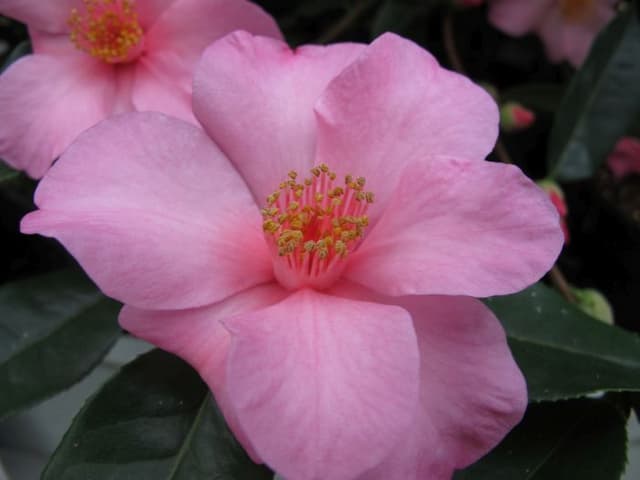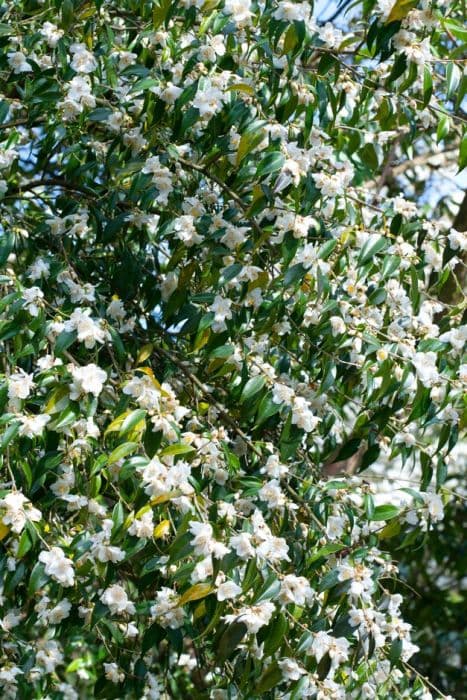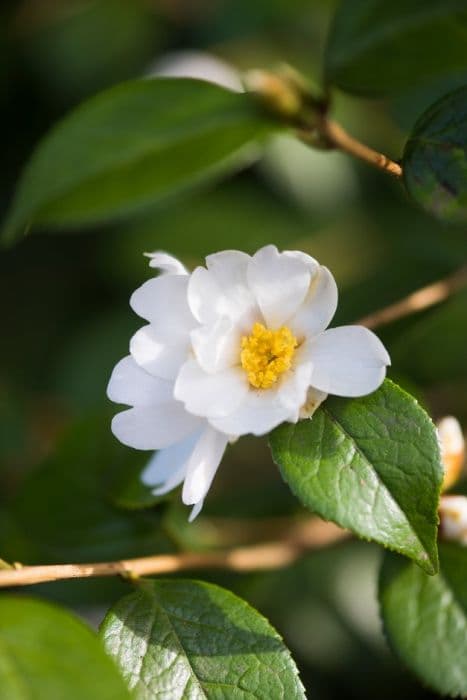Anticipation Camellia Camellia × williamsii 'Anticipation'

ABOUT
Camellia 'Anticipation' is an evergreen shrub adorned with glossy, deep green leaves which provide a rich, lustrous backdrop throughout the year. The leaves are typically oval-shaped and come to a subtle point, having slightly serrated edges that give them a refined texture. The true spectacle of this plant, however, is its flowers. The blooms are large, peony-like and richly colored in a bold shade of pink, creating an eye-catching display. Each flower consists of numerous ruffled petals that are densely packed together, forming a full and rounded appearance. The blooms of the Camellia 'Anticipation' are a highlight in the late winter to early spring garden when many other plants are still dormant. They have a luxurious quality, with the petals often showing a deeper shade of pink at the edges, which fades to a softer hue as they move toward the center. The flowers are substantial enough to make a statement whether planted en masse, as a solitary specimen, or even when cut and arranged in a vase indoors. 'Anticipation' often forms buds that are equally decorative, starting out as small, tight spheres that gradually swell and hint at the riot of color they're about to unfurl. These buds are nestled within the plant's foliage, offering a promise of beauty even before they open. Camellia 'Anticipation' carries a sense of elegance and vitality, making it a cherished plant for gardeners seeking to add a touch of drama and color to their landscape.
About this plant
 Names
NamesFamily
Theaceae.
Synonyms
Williamsii Camellia, Hybrid Camellia Anticipation.
Common names
Camellia × williamsii 'Anticipation'
 Toxicity
ToxicityTo humans
Camellia x williamsii 'Anticipation', commonly known as Camellia, is not considered toxic to humans. In general, camellias are not listed among plants that pose a risk of poisoning when ingested or handled. Therefore, accidental ingestion of camellia leaves or flowers would not typically result in poisoning or adverse health effects. However, as with any non-food plant, individual sensitivities can vary, and ingesting plant material may cause mild stomach upset for some people.
To pets
Camellia x williamsii 'Anticipation', commonly known as Camellia, is generally not considered toxic to pets. Camellias are not known to contain substances that are harmful to pets such as dogs or cats. Therefore, if a pet were to ingest parts of a Camellia plant, it would not typically result in poisoning. Nonetheless, ingestion of non-food plants can sometimes cause mild gastrointestinal upset in pets, such as vomiting or diarrhea, due to the irritation of the stomach or intestines. If a pet ingests a large amount of the plant and shows signs of distress, it is advisable to consult a veterinarian.
 Characteristics
CharacteristicsLife cycle
Perennials
Foliage type
Evergreen
Color of leaves
Green
Flower color
Pink
Height
6-8 feet (1.8-2.4 meters)
Spread
5-7 feet (1.5-2.1 meters)
Plant type
Shrub
Hardiness zones
7-9
Native area
Japan China
Benefits
 General Benefits
General Benefits- Ornamental Appeal: Camellia × williamsii 'Anticipation' is valued for its large, showy flowers that make striking additions to any garden landscape.
- Extended Blooming Season: This variety tends to bloom from late winter to early spring, providing color during a time when few other plants are in flower.
- Drought Resistance: Once established, it has a moderate tolerance to drought, requiring less water compared to many other plants.
- Shade Tolerance: It can grow in partial shade, offering options for gardeners with shaded areas.
- Erosion Control: The dense growth habit can help prevent soil erosion on slopes and banks.
- Privacy Screen: When planted in groups, it can provide a dense screen for privacy and wind protection.
- Wildlife Attraction: The blossoms can attract pollinators like bees, providing a habitat and food source for them.
- Low Maintenance: It generally requires minimal care once established, other than occasional pruning to maintain shape.
- Versatility: Suitable for a variety of landscapes, including formal gardens, woodland settings, and containers for patios or terraces.
 Medical Properties
Medical PropertiesThis plant is not used for medical purposes.
 Air-purifying Qualities
Air-purifying QualitiesThis plant is not specifically known for air purifying qualities.
 Other Uses
Other Uses- Artistic Inspiration: Camellia × williamsii 'Anticipation' often serves as a muse for artists and photographers due to its striking blossoms and elegant form, inspiring paintings, drawings, and photographic projects.
- Educational Tool: Horticulture teachers and educators may use this plant to demonstrate hybridization, plant care, and blooming cycles in educational settings.
- Fabric Dyeing: The petals of Camellia × williamsii 'Anticipation' can be used to produce natural dyes for fabric, although this is not a widespread practice.
- Symbolic Gift: In some cultures, giving Camellia flowers is a way to express desire or deep longing, so the plant could be cultivated specifically for this purpose.
- Culinary Garnish: Although not commonly consumed, the petals can be used as a decorative, non-toxic garnish for dishes in high-end culinary presentations.
- Botanical Illustration: This plant is a subject for botanical illustrators who meticulously document plant species in detailed drawings for scientific records or art pieces.
- Floral Arrangements: The blooms are often used in flower arrangements, including wedding bouquets and centrepieces due to their beauty and fullness.
- Garden Design: The plant is used in ornamental gardening not only for its appearance but also as a structural plant due to its size and form.
- Winter Interest: Because of its ability to bloom in late winter or early spring, the plant adds color and interest to gardens during a time when few other plants are flowering.
- Perfumery: Although not common, the scent of the flowers could potentially be used in making perfumes or scented products.
Interesting Facts
 Feng Shui
Feng ShuiThe Camellia is not used in Feng Shui practice.
 Zodiac Sign Compitability
Zodiac Sign CompitabilityThe Camellia is not used in astrology practice.
 Plant Symbolism
Plant Symbolism- Admiration: The Camellia often symbolizes deep admiration for someone's qualities and spirit.
- Perfection: With its perfect, intricate petals, the Camellia represents the ideal of perfection and excellence.
- Longevity: The sturdy nature of the Camellia plant suggests endurance and the ability to thrive for a long time.
- Love: The beauty of Camellias is frequently associated with romantic love, much like roses in Western culture.
- Affection: Giving someone this Camellia can symbolize genuine affection and strong emotional bonds.
 Water
WaterThe williamsii camellia 'Anticipation' requires consistent moisture, so water deeply when the top inch of soil becomes dry, which can vary from once a week to every two weeks, depending on climate and weather conditions. Aim to apply about 1-1.5 gallons of water for medium-sized shrubs each time you water, ensuring even soil saturation. During the growing season in spring and summer, outdoor plants may need more frequent watering, especially in dry spells. In winter, reduce the frequency but do not allow the soil to completely dry out. Overhead watering is not recommended, as it can promote fungal diseases; instead, water at the base of the plant.
 Light
LightThe williamsii camellia 'Anticipation' thrives best in partial shade to filtered sunlight. It should be placed in a location where it is protected from intense afternoon sun, which can scorch the leaves. Morning light with dappled afternoon shade is ideal. Ensure the plant is positioned where it can receive several hours of soft light daily for optimal bloom and health.
 Temperature
TemperatureWilliamsii camellia 'Anticipation' prefers cooler temperatures ranging from 40 to 70 degrees Fahrenheit and will thrive in USDA zones 7 to 9. It can tolerate short periods of lower temperatures down to about 10 degrees Fahrenheit but should be protected from prolonged freezes. To encourage bud formation, a period of 6 to 8 weeks of winter chill is beneficial, where temperatures are steady between 32 to 45 degrees Fahrenheit.
 Pruning
PruningPrune the williamsii camellia 'Anticipation' immediately after flowering to maintain its shape and to encourage new growth and blooms for the following season. Remove any dead or crossing branches and thin out dense growth to enable light and air penetration. Pruning every year or every other year is typically sufficient. Avoid heavy pruning late in the year as it may remove next season’s flower buds.
 Cleaning
CleaningAs needed
 Soil
SoilCamellia 'Anticipation' thrives in well-draining, acidic soil with a pH between 5.5 and 6.5. A recommended soil mix for camellias includes equal parts of peat moss, pine bark, and perlite or coarse sand. Additionally, incorporating organic matter like compost can help improve soil structure and provide essential nutrients.
 Repotting
RepottingCamellia 'Anticipation' typically requires repotting every 2-3 years to prevent root crowding and to refresh the soil. It's best to repot in the spring just before the growing season begins, using a slightly larger pot each time to accommodate root growth.
 Humidity & Misting
Humidity & MistingCamellia 'Anticipation' prefers high humidity levels, ideally between 50% to 60%. To maintain these conditions, especially during dry winter months or in arid climates, a humidifier or regular misting can help achieve the desired humidity.
 Suitable locations
Suitable locationsIndoor
Provide bright, filtered light, and keep the soil slightly moist.
Outdoor
Plant in partial shade, shelter from cold winds, mulch well.
Hardiness zone
7-9 USDA
 Life cycle
Life cycleThe Camellia × williamsii 'Anticipation', commonly known as Camellia 'Anticipation', begins its life cycle with seed germination, although cultivated plants are often propagated through cuttings to maintain specific cultivar traits. The plant then enters a juvenile growth phase where it develops its root system and foliage. As it matures, Camellia 'Anticipation' enters the vegetative stage, producing glossy, evergreen leaves which remain on the plant year-round. Eventually, the plant reaches the flowering stage, typically in late winter to spring, showcasing large, peony-form blossoms in shades of deep pink. Once pollinated, the flowers develop into dry capsules, which upon maturing, release seeds to potentially begin a new cycle. Throughout its life, Camellia 'Anticipation' may experience cycles of growth and dormancy annually, with active growth in spring and summer, and reduced growth in fall and winter.
 Propogation
PropogationPropogation time
Early Spring
The Camellia × williamsii 'Anticipation', commonly known as the 'Anticipation' camellia, is typically propagated through semi-hardwood cuttings. The best time for taking cuttings is during the late summer. To do this, select healthy, semi-hardwood stems that are not bearing flowers. Cuttings should be about 4 to 6 inches (10 to 15 centimeters) long and include several sets of leaves. The lower leaves are removed, and the cut end is dipped in rooting hormone to encourage root development. The prepared cutting is then inserted into a pot containing a mixture of peat and perlite or a similar well-draining propagation medium. The cuttings need to be kept in a humid environment, typically under a plastic cover or in a greenhouse, with indirect light until roots have formed, which usually takes several months.









